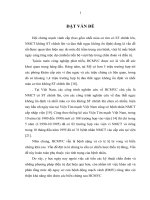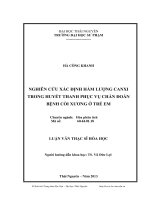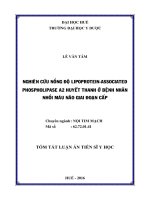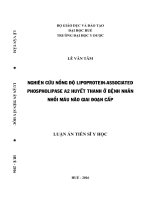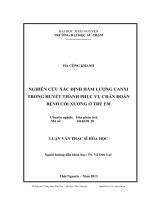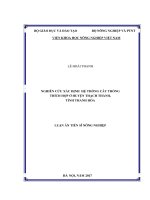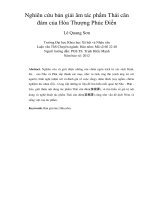DSpace at VNU: Nghiên cứu xác định hệ protein màng trong huyết thanh của bệnh nhân mắc hội chứng mạch vành cấp
Bạn đang xem bản rút gọn của tài liệu. Xem và tải ngay bản đầy đủ của tài liệu tại đây (295.9 KB, 8 trang )
Nghiên cứu xác định hệ protein màng trong
huyết thanh của bệnh nhân mắc hội chứng
mạch vành cấp
Trần Thái Thượng
Trường Đại học Khoa học Tự nhiên
Luận văn ThS. Chuyên ngành: Sinh học thực nghiệm; Mã số: 60 42 01 14
Người hướng dẫn: TS. Lê Thị Bích Thảo, PGS.TS. Trịnh Hồng Thái
Năm bảo vệ: 2011
Abstract: Nhận diện các protein màng có trong huyết thanh bệnh nhân mắc hội chứng
mạch vành cấp. Xây dựng và phân tích dữ liệu cơ bản về các protein này. Dự đoán số vùng
xuyên màng trong cấu trúc các protein màng
Keywords: Sinh học; Sinh học thực nghiệm; hệ protein màng; Bệnh mạch vành cấp.
Content:
MỞ ĐẦU
Hội chứng mạch vành cấp (Acute Co
ronary Syndrome, ACS) thường xảy ra bất ngờ, đột ngột, có tỉ lệ tử vong cao và để lại
nhiều di chứng nặng nề nếu không được cấp cứu kịp thời. Ở Việt Nam, do áp lực công việc
ngày càng tăng cao cùng với thói quen ăn uống không cân đối, tình trạng thừa cân, béo phì
hay hút thuốc lá đã dẫn đến tỉ lệ các bệnh lí tim mạch nói chung và ACS nói riêng tăng lên
rõ rệt trong những năm gần đây. Hội chứng mạch vành cấp thường liên quan đến những
biến đổi bất thường xảy ra bên trong dòng máu. Hơn nữa, dòng máu tuần hoàn gần như
khắp cơ thể, tiếp xúc với hầu hết các tế bào nên rất nhiều biến đổi trong cơ thể được phản
ánh vào trong máu. Huyết thanh là thành phần chính của máu, là môi trường cho các tế bào
máu hoạt động nên những biến đổi này cũng được phản ánh trong huyết thanh. Do đó,
huyết thanh đã được lựa chọn như một trong những đối tượng nghiên cứu chính trong
nhiều bệnh lí, đặc biệt là tim mạch. Đã có rất nhiều nghiên cứu được thực hiện trên huyết
thanh nhưng gần đây hướng tiếp cận về protein màng đang thu hút được sự quan tâm của
các nhà khoa học.
Protein màng có vai trò then chốt trong các hoạt động sống của tế bào vì chúng thực hiện
rất nhiều chức năng quan trọng. Những thay đổi bất thường trong hoạt động của các
protein này chính là dấu hiệu nhận biết sự phát sinh và phát triển bệnh lí. Những năm gần
đây các nghiên cứu về protein đặc biệt là protein màng đang rất được quan tâm và đầu tư.
Cùng với sự ra đời, phát triển của tin sinh học và các kĩ thuật phân tích dựa trên phổ khối
lượng, cách tiếp cận proteomics đang cho thấy đây là một phương pháp hữu hiệu và khó có
thể thay thế trong việc phân tích các hệ protein trong cơ thể. Tại Việt Nam, những nghiên
cứu proteomics đã được tiến hành trong một số năm qua và đạt được những kết quả nhất
định.
Trên cơ sở đó chúng tôi đã thực hiện đề tài “Nghiên cứu xác định hệ protein màng trong
huyết thanh của bệnh nhân mắc hội chứng mạch vành cấp” với mục đích:
1. Nhận diện các protein màng có trong huyết thanh bệnh nhân mắc hội chứng mạch
vành cấp.
2. Xây dựng và phân tích dữ liệu cơ bản về các protein này.
3. Dự đoán số vùng xuyên màng trong cấu trúc các protein màng.
Đề tài được thực hiện tại Phòng Thí nghiệm Trọng điểm Công nghệ Gen, Viện Công nghệ
Sinh học, Viện Hàn lâm Khoa học và Công nghệ Việt Nam.
TÀI LIỆU THAM KHẢO
Tiếng Việt
1.
Phan Văn Chi (2006), Proteomics: Khoa học về hệ protein, Viện Khoa học và Công
nghệ Việt Nam, Hà Nội.
2.
Phan Văn Chi (2009), “Thực trạng nghiên cứu về Proteomics”, Hội thảo
VNProteomics lần 1, Nhà xuất bản Khoa học Tự nhiên và Công nghệ, Hà Nội.
3.
Trần Văn Dương (2000), “Vai trò của chụp động mạch vành trong chẩn đoán và điều
trị bệnh ĐMV”, Kỷ yếu toàn văn các đề tài khoa học Đại hội Tim mạch học Quốc
gia Việt nam lần thứ VII, tr. 483-489.
4.
Đỗ Ngọc Liên (2004), Miễn dịch học cơ sở, Nhà xuất bản Đại học Quốc gia, Hà Nội.
5.
Đỗ Trung Phấn (2004), Bài giảng huyết học-truyền máu, Nhà Xuất bản Y Học, Hà
Nội.
6.
Nguyễn Thị Minh Phương, Trần Thái Thượng, Phạm Đức Đan, Đỗ Hữu Chí, Nguyễn
Bích Nhi, Đặng Minh Hải, Đỗ Doãn Lợi, Phan Văn Chi (2013), “Mức độ biểu
hiện của protein bền nhiệt trong huyết thanh bệnh nhân mắc hội chứng mạch vành
cấp”, Tạp chí Y học Việt Nam, 410(2), tr. 114-120.
7.
Hoàng Văn Sơn (2009), “Proteomics lâm sàng”, Hội thảo VNProteomics lần I, Nhà
xuất bản Khoa học Tự nhiên và Công nghệ, Hà Nội.
Tiếng Anh
8.
Adkins J., Susan N., Varnum M., Auberry K. J. (2002), “Toward a human bloodserum
proteome analysis by multimensional seperation coupled with mass
spectrometry”, Molecular Cellular proteomics, 1, pp. 947-955.
9.
Almén M. S., Nordström K. J. V., Fredriksson R., Schiöth H. B. (2009), “Mapping the
human membrane proteome: a majority of the human membrane proteins can be
classified according to function and evolutionary origin”, BioMed Central
Biology, 7(50), pp. 1-14.
10. Anderson J. L., Adams C. D., Antman E. M. (2007), “ACC/AHA guidelines for the
management of patients with unstable angina/non-ST-Elevation myocardial
infarction: a report of the American College of Cardiology”, Journal of American
Heart Association, 116, pp. 148-304.
11. Anderson N. L., Anderson N. G. (1998), “Proteome and proteomics: new
technologies, new concepts, and new words, Electrophoresis, 19(11), pp. 18531861.
12. Anderson N. L., Anderson N. G. (2002), “The human plasma proteome, history,
character and diagnostic prospects”, Molecular & Cellular Proteomics, 1(10), pp.
845-867.
13. Anderson, N. L., Anderson N. G. (2003), “The Human Plasma Proteome: History,
Character, and Diagnostic Prospects”, Molecular & Cellular Proteomics, 2(1), pp.
50.
14. Anderson N. L., Polanski M., Rembert P., Gatlin T., Tirumalai R. S., Conrads T. P.,
Veenstra T. D., Adkins J. N., Pounds J. G., Fagan R., Anna L. (2004), “The
Human Plasma Proteome-A Nonredundant List Developed by Combination of
Four Separate Sources”, Molecular & Cellular Proteomics, 3, pp. 311-326.
15. Bashore T. M., (2001), “American College of Cardiology/Society for Cardiac
Angiography and Interventions Clinical Expert Consensus Document on Cardiac
Catheterization Laboratory Standards. A Report of the American College of
Cardiology Task Force - 50 -on Clinical Expert Consensus Documents”, Journal
of the American College of Cardiology, 37, pp. 2170-2214.
16. Chan K. C., Lucas D. A., Hise D., Schaefer C. F., Xiao Z., Janini G. M., Kenneth H.
B., Haleem J. I., Veenstra T. D., Conrads T. P. (2004), “Analysis of the Human
serum proteome”, Clinical Proteomics I, 1(2), pp. 101-225.
17. Cnop M., Welsh N., Jonas J. C., Jorns A. (2005), “Mechanisms of pancreatic beta-cell
death in type 1 and type 2 diabetes: many differences, few similarities”, Diabetes,
54, pp. 97-107.
18. Da Cruz S., Martinou J. C. (2008), “Purification and proteomic analysis of the mouse
liver mitochondrial inner membrane”, Methods in Molecular Biology, 432, pp.
101-116.
19. Das S., Hahn Y., Nagata S., Willingham M. C. (2007), “NGEP – a prostate – specific
plasma membrane protein that promotes the association of LNCaP cells”, Cancer
Research, 67, pp. 1594–1601.
20. Dhillon A. S., Hagan S., Rath O., Kolch W. (2007), “MAP kinase signalling pathways
in cancer”, Oncogene, 26, pp. 3279–3290.
21. Dung N. T., Chi D. H., Thao L. T. B., Dung N. T. K., Nhi N. B. and Chi P. V. (2013),
“Identification and Characterization of Membrane Proteins from Mouse Brain
Tissue”, Journal Proteomics & Bioinformatics, 6(6), pp. 142-147.
22. Foster L. J., Zeemann P. A., Li C., Mann M. (2005), “Differential expression profiling
of membrane proteins by quantitative proteomics in a human mesenchymal stem
cell line undergoing osteoblast differentiation”, Stem Cells, 23, pp. 1367–1377.
23. Franklin S., Zhang M. J., Chen H., Paulsson A. K., Mitchell-Jordan S. A., Li Y., Ping
P., Vondriska T.M. (2010), “Specialized compartments of cardiac nuclei exhibit
distinct proteomic anatomy”, Molecular & Cellular Proteomics, pp 10.
24. Gianazza E., Arnaud P. (1982), “General method for fractionation of plasma protein:
Dye-ligand affinity chromatography on immobillized Cibacron Blue F3-GA”,
Biochemical Journal, 201, pp. 129-136.
25. Gloriam D., Foord S., Blaney F., Garland S. (2009), “Definition of the G proteincoupled receptor transmembrane bundle binding pocket and calculation of
receptor similarities for drug design”, Journal of Medicinal Chemistry, 52, pp.
4429–4442.
26. Hunt D., Henderson R., Shabanowitz J., Sakaguchi K., Michel H., Sevilir N., Cox A.,
Appella E., and Engelhard V. (1992), “Characterization of peptides bound to the
class I MHC molecule HLA-A2.1 by mass spectrometry”, Science, 255(5049), pp.
1261-1263.
27. International Diabetes Federation (2003), “Metabolic syndrome -driving the CVD
epidemic”, Avenue Emile De Mot 19 B-1000 Brussels, Belgium, pp. 1-3.
28. Kabbani N. (2008), “Proteomics of membrane receptors and signaling”,
Proteomics, 8, pp. 4146-4155.
29. Kislinger T., Cox B., Kannan A., Chung C., Hu P., Ignatchenko A., Scott M. S.,
Gramolini A. O., Morris Q., Hallett M. T., Rossant J., Hughes T. R., Frey B.,
Emili A. (2006), “Global Survey of Organ and Organelle Protein Expression in
Mouse: Combined Proteomic and Transcriptomic Profiling” Cell, 125, pp. 173186.
30. Lallet-Daher H., Roudbaraki M., Bavencoffe A., Mariot P. (2009), “Intermediateconductance Ca21-activated K1channels (IKCa1) regulate human prostate cancer
cell proliferation through a close control of calcium entry”, Oncogene, 28, pp.
1792-1806.
31. Li J., Kelly J. F., Chernushevich I., Harrison D. J., Thibault P. (2000), “Separation and
Identification of Peptides from Gel-Isolated Membrane Proteins Using a
Microfabricate dDevice for Combined Capillary Electrophoresis/
Nanoelectrospray Mass Spectrometry”, Analytical Chemistry, 72, pp. 599-609.
32. Liebler D. C. (2002), Introduction to Proteomics, Humana Press, Totowa, New Jersey.
33. Lindmark R., Thoren-Tolling K., Sjoquist J. (1983), “Binding of Immunoglobulins to
Protein A and Immunoglobulin Levels in Mammalian Sera”, Journal of
Immunological Methods, 62, pp. 1-13.
34. Liu X., Zhang M., Go V. L., (2010), “Membrane proteomic analysis of pancreatic
cancer cells”, Journal of Biomedical Science;17(1), pp. 17-74.
35. Lodish H., Berk A., Zipursk S. L., Matsudaira P. (2002), Molecular Cell Biology, 4th
Edition, W. H. Freeman and Company, New York.
36. Mackay J., Mensah G. A. (2004), "Deaths From coronary heart disease", The atlas of
heart disease and stroke-WHO, Geneva, pp. 48-49.
37. Maruyama T., Tanaka S., Shimada A., Funae O. (2008), “Insulin intervention in
slowly progressive insulin-dependent (type 1) diabetes mellitus”, The Journal of
Clinical Endocrinology & Metabolism, 93, pp. 2115-2121.
38. Morandell S., Stasyk T., Skvortsov S., Ascher S., Huber L. A. (2008), “Quantitative
proteomics and phosphoproteomics reveal novel insights into complexity and
dynamics of the EGFR signaling network”, Proteomics, 8, pp. 4383-4401.
39. Nguyen V., Cao L., Lin J. T., Hung N. (2009), “A new approach for quantitative
phosphoproteomic dissection of signaling pathways applied to T cell receptor
activation”. Molecular & Cellular Proteomics, 8, pp. 2418-2431.
40. Nielsen P. A., Olsen J. V., Podtelejnikov A. V., (2005), “Proteomic mapping of brain
plasma membrane proteins”, Molecular & Cellular Proteomics, 4(4), pp. 402-408.
41. Olsen J. V., Blagoev B., Gnad F., Macek B. (2006), “Global, in vivo, and site-specific
phosphorylation dynamics in signaling networks”, Cell, 127, pp. 635-648.
42. Pallister C. J.,Watson M. S. (2010), Haematology, Scion Publishing, Banbury, UK, pp.
334-336.
43. Parker B. L., Palmisano G., Edwards A. V. G., White M. Y., Engholm-Keller K., Lee
A., Scott N. E., Kolarich D., Hambly B. D., Packer N. H., Larsen M. R., Cordwell
S. J. (2011), “Quantitative N-linked Glycoproteomics of Myocardial Ischemia and
Reperfusion Injury Reveals Early Remodeling in the Extracellular Environment”,
Molecular & Cellular Proteomics, 10, pp. 1-10
44. Parveen S., Jake C., Anthony O. G. (2013), “Recent advances in cardiovascular
proteomics”, Journal of Proteomics, 81, pp. 3-14.
45. Ren L., Hong S. H., Cassavaugh J., Osborne T. (2009), “The actin-cytoskeleton linker
protein ezrin is regulated during osteosarcoma metastasis by PKC”, Oncogene,
28, pp. 792–802.
46. Thanh T. T., Chi P. V. (2010), “Separation and identification of mouse liver
membrane proteins using a gel-based approach in combination with 2DnanoLCQ-TOF-MS/MS”, Advances In Natural Sciences: Nanoscience and
Nanotechnology, 1, pp. 1-7.
47. Tirumalai R. S., Chan K. C., Prieto D. A., Issaq H. J., Conrads T. P., Veenstra T. D.
(2004), “Characterization of the Low Molecular Weight Human Serum
Proteome”, Molecular & Cellular Proteomics, 2, pp. 1096-1103.
48. Turner M. W., Hulme B. (1970), The Plasma Proteins: An Introduction, Pitman
Medical &Scientific Publishing Co. Ltd., London.
49. Verrills, N. M. (2006), “Clinical proteomics: present and future prospects”, The
Clinical biochemist. Reviews/Australian Association of Clinical”, Biochemists,
27(2), pp. 99-116.
50. Wilkins M. R., Sanchez J. C., Gooley A. A., Appel R. D., Humphery-Smith I.,
Hochstrasser D. F., and Williams K. L. (1996), “Progress with proteome projects:
why all proteins expressed by a genome should be identified and how to do it”,
Biotechnology & genetic engineering reviews, 13, pp. 19-50.
51. Yu, L. (2013), "Genetic and pharmacological inhibition of galectin-3 prevents cardiac
remodeling by interfering with myocardial fibrogenesis", Circulation: Heart
Failure, 6(1), pp. 107–117.
52. Zhang L., Xie J., Wang X., Liu X. (2005), Proteomic analysis of mouse liver plasma
membranes: use of differential extraction to enri hydrophobic membrane proteins.
Proteomics, 5, pp. 4510–4524.
World Wide Web
53. (21/12/2013)
54. />diseases/anatomy_and_function_of_the_coronary_arteries_85,P00196/
(06/12/2013)
55. (15/11/2013)
56. />57. (29/11/2013)
